- A quick refresher of the 1-persistent CSMA protocol:
- Fact
of the 1-persistent CSMA protocol:
- When a node senses that the channel is busy, it will wait for the end of the transmission and transmit immediately
- Consequence of this
fact:
- All nodes that sense the channel is busy (during some node's transmission) will transmit their packets at the end of the current transmission
- Fact
of the 1-persistent CSMA protocol:
- Transmission pattern in the 1-persistent CSMA protocol:
- When observing the 1-persistent CSMA
protocol, you will see the following
transmission pattern:

Notes:
- There are again a series of interleaved
busy periods and
idle periods
- Each cyle starts with an
idle period,
followed by
a busy period
- A busy period in the
1-persistent CSMA protocol
consists of
one or more transmission periods
(A busy period in the non-persistent CSMA protocol consists of exactly one transmission period
This is because when a node senses that the channel is busy in the non-persistent CSMA protocol, it will leave the queueing system)
- There are again a series of interleaved
busy periods and
idle periods
- When observing the 1-persistent CSMA
protocol, you will see the following
transmission pattern:
- Anatomy of the 1-persistent CSMA busy period:
- The transmission periods
inside one busy period can be
of the following type:

Notes:
- There are two different types of
transmission periods
inside a busy period
- The first type is
a transmission period where
the number of packet arrivals
at the start
of the transmission period
is equal to
1
- We call this a type 1 period
Type 1 periods can become useful
- A type 1 period
can
contain a collision
when another packet arrives
during the vulnerable period:
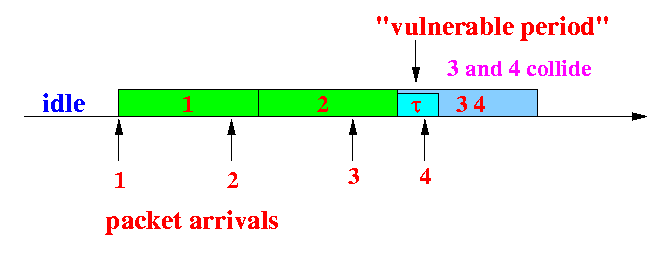
- Note:
- All three periods
in the figure
are type 1 periods
(There is only one packet arrival at the start of the period
- The period #1 and #2 are
useful periods
because the packet arrival
will not cause
a collision
- The period #3 is
notuseful because
the arrival of packet 4
will cause a collision
- The first transmission period
in a busy period is always
a type 1 period
(Because there are no simultaneous arrivals in a Poisson Arrival process)
- All three periods
in the figure
are type 1 periods
- The other type is
a transmission period contains
a transmission of 2 or more packets
- We call this a type 2 period
Example:

The period #3 (with cyan color) is a type 2 period
- A type 2 period is started when there are 2 or more arrivals during the previous transmission period
Type 2 periods are certainly not useful
(because there will be a collision in the transmission period)
- There are two different types of
transmission periods
inside a busy period
- According to the same principle
(counting the number of arrivals in the
previous
transmission period),
we see that:
- An idle period is started when there is 0 arrival during the previous transmission period
We will use a similar nomenclature for the idle period:
- An idle period is called a type 0 period
- The transmission periods
inside one busy period can be
of the following type:
- Definitions of the different states:
- State 0 =
the number of packet arrivals
at the start
of the transmission period
is equal to
0
- State 1 =
the number of arrivals
at the start
of the transmission period
is equal to
1
- State 2 = the number of arrivals at the start of the transmission period is equal to 2
- State 0 =
the number of packet arrivals
at the start
of the transmission period
is equal to
0
- The state transition diagram
of the 1-persistent (unslotted) CSMA
protocol:
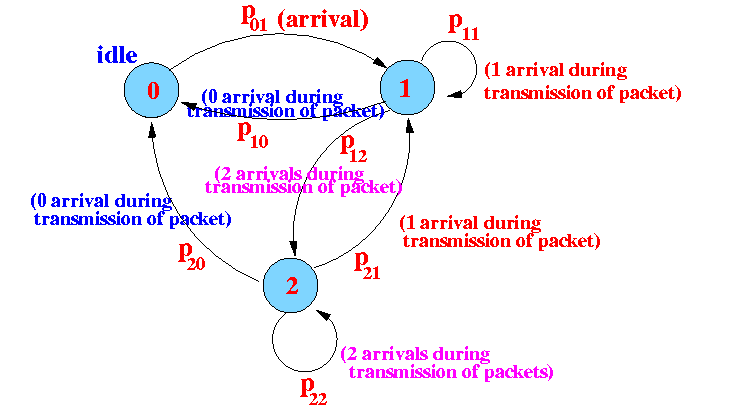
- Example state transitions:
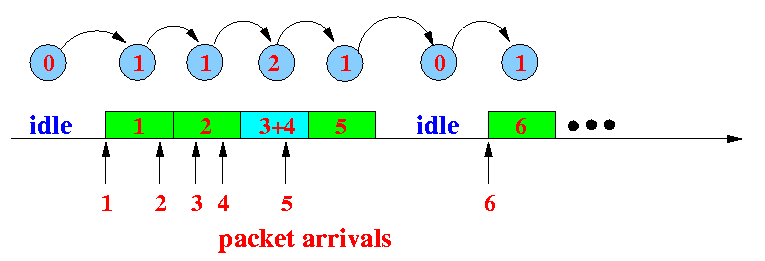
- Definitions and notations:
- πi =
steady state probability of
the system in
state i (for i = 0, 1, 2)
- Ti =
random variable
representing
the
length (duration) of a
type i period (for i = 0, 1, 2)
Ti = E[T] (i.e., the average length (duration) of a type i period (for i = 0, 1, 2)
Note:
- Do not confuse the
random variable
Ti with the
constant
T
- Recall that:
- T =
length (duration)
of a packet transmission
This value is constant
- T =
length (duration)
of a packet transmission
- πi =
steady state probability of
the system in
state i (for i = 0, 1, 2)
- Throughput of the unslotted 1-persistent CSMA protocol:
π0T × Ҏ[ success in T0 ] + π1T × Ҏ[ success in T1 ] + π2T × Ҏ[ success in T2 ] S = --------------------------------------------------------------------------------- π0T0 + π1T1 + π2T2 π0T × 0 + π1T × Ҏ[ 0 arrival in τ sec ] + π2T × 0 <=> S = ---------------------------------------------------------- π0T0 + π1T1 + π2T2 π1T × e-gτ <=> S = --------------------- .......... (1) π0T0 + π1T1 + π2T2Notes:
- The expression:
- πiTi + π1T1 + π2T2
in the denominator is the average duration (length) of one transmission period
Example:
- Suppose 40% of the time, the
system is in state 0 that last approximately
5 min,
50% of the time, the
system is in state 1 that last approximately
1 min, and
10% of the time, the
system is in state 2 that last approximately
2 min, then
the average duration of
one period is:
- 0.4 × 5 + 0.5 × 1 + 0.1 × 2
- The expression:
- πiT × Ҏ[ success in Ti ]
in the nominator is the portion of the duration "πiTi" that is useful (successful packet transmission
- The expression:
- What remains to be done:
- Compute the
average durations
T0,
T1 and
T2
- And compute the steady state probabilities π0, π1 and π2
- Compute the
average durations
T0,
T1 and
T2
- The type 0 period is an
idle period
Hence:
- T0 = average duration of an idle period
- The duration of
an idle period
depends only on
the arrival process
- Since the arrival process is a Poisson process with arrival rate g, the duration of an idle period in 1-persistent CSMA is the same as the duration of an idle period in non-persistent CSMA
- Therefore:
1 T0 = --- ........ (2) (See: click here) g
- Note:
- Although there is
one arrival at the
start of
a type 1 period,
it is not true that
a type 1 period
will always
contain
one packet transmission
- The number of packets transmitted in a type 1 period depends on the number of arrivals during the vulnerable period of the initiating transmission
- Although there is
one arrival at the
start of
a type 1 period,
it is not true that
a type 1 period
will always
contain
one packet transmission
- Anatomy of a type 1 transmission period:
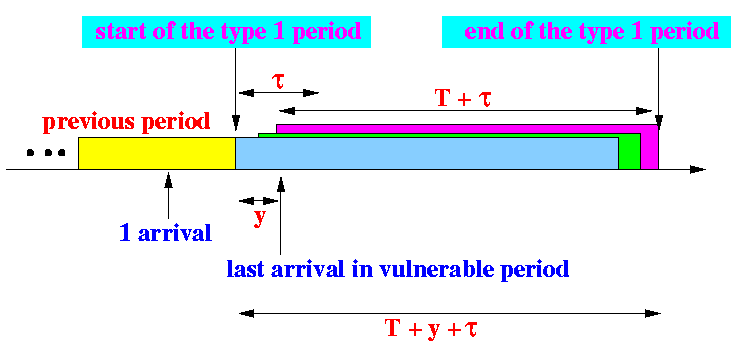
- Notes:
- y =
a random variable representing the
arrival time of the
last arriving transmission
in the vulnerable period
(See: click here)
- y =
a random variable representing the
arrival time of the
last arriving transmission
in the vulnerable period
- We have that:
- T1 = T + τ + y
(For detail on why you have &tau in the expression, see: click here)
Therefore:
E[T1] = T + τ + E[y]
- The random variable
y
(arrival time of the last arriving packet) depends
only on the
arrival process
For a Poisson arrival process with arrival rate g, we have previously determined that (see: click here)
1 - e-gτ y = τ - --------- ........ (3) g
- Therefore, the
average duration
of a type 1 period is:
E[T1] = T + τ + E[y]
Or: 1 - e-gτ T1 = T + 2τ - --------- ...... (4) g
- Note:
- Similar
to the type 1 period:
- Although there are N arrivals at the start of a type 2 period, it is not true that a type 2 period will always contain N packet transmissions
- The number of packets transmitted in a type 2 period also depends on the number of arrivals during the vulnerable period of the initiating transmissions
- Similar
to the type 1 period:
- Anatomy of a type 2 transmission period:
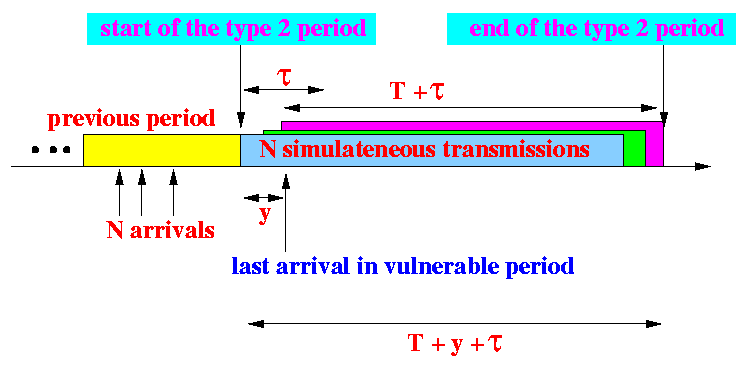
- Notes:
- y =
a random variable representing the
arrival time of the
last arriving transmission
in the vulnerable period
(See: click here)
- y =
a random variable representing the
arrival time of the
last arriving transmission
in the vulnerable period
- We see that:
- The duration of a type 2 period is identical to the duration of a type 1 period !!!
- Therefore:
E[T2] = E[T1]
Or: 1 - e-gτ T2 = T + 2τ - --------- ...... (5) g
OK, we got expressions for T0, T1 and T2....
Now we find the steady state probabilities π0, π1 and π2....
- Here we apply the
material from
Markov chain....
(We get to finally use this !!! :-))
- However, before we can
apply the Markov analysis,
we must first
determine the
transistion probabilities
p00,
p01,
p02,
p10, ...
- Unlike artificially created Markov chains with chosen transition probabilities (such as those in your homework assignment), real-life systems have transition probabilities that must be discovered by analysis
Consider the state transition diagram:

- The steady state probabilities
π0,
π1,
π2
are computed
using the following equations:
(See:
click here)
π0 = π0p00 + π1p10 + π2p20 π1 = π0p01 + π1p11 + π2p21 π2 = π0p02 + π1p12 + π2p22
From the diagram, we have: p00 = 0 and p02 = 0 Subst: p00 = 0 and p02 = 0 in the equations: π0 = π1p10 + π2p20 π1 = π0p01 + π1p11 + π2p21 π2 = π1p12 + π2p22
From: p00 + p01 + p02= 1 and: p00 = 0 and: p02 = 0 We have: p01 = 1 Substitute p01 = 1: π0 = π1p10 + π2p20 π1 = π0 + π1p11 + π2p21 π2 = π1p12 + π2p22
- Further simplification:
- The transition probability from
state 1 to state 0
(p10)
depends on the number of arrivals
in a type 1 period
(Specifically: state 0 is reached when there are no arrivals within the type 1 period)
The transition probability from state 2 to state 0 (p20) also depends on the number of arrivals in a type 2 period
(Specifically: state 0 is reached when there are no arrivals within the type 2 period)
Recall that:
- The duration of a type 1 period and a type 2 period have the same probability distribution !!! (See: click here and click here)
Because the arrival process to type 1 and type 2 periods are also identical (Poisson with rate g), we conclude that:
- p10 = p20
- The transition probability from
state 1 to state 1
(p11)
depends on the number of arrivals
in a type 1 period
(Specifically: state 1 is reached when there are exactly 1 arrival within the type 1 period)
The transition probability from state 2 to state 1 (p21) also depends on the number of arrivals in a type 2 period
(Specifically: state 1 is reached when there are exactly 1 arrival within the type 2 period)
Recall again that:
- The duration of a type 1 period and a type 2 period have the same probability distribution !!! (See: click here and click here)
Because the arrival process to type 1 and type 2 periods are also identical (Poisson with rate g), we conclude that:
- p11 = p21
- The transition probability from
state 1 to state 2
(p10)
depends on the number of arrivals
in a type 1 period
(Specifically: state 2 is reached when there are more than 2 arrivals within the type 1 period)
The transition probability from state 2 to state 0 (p20) also depends on the number of arrivals in a type 2 period
(Specifically: state 2 is reached when there are more than 2 arrivals within the type 2 period)
Same old story again, recall that:
- The duration of a type 1 period and a type 2 period have the same probability distribution !!! (See: click here and click here)
Because the arrival process to type 1 and type 2 periods are also identical (Poisson with rate g), we conclude that:
- p12 = p22
Result after substitution:
Before substitution: π0 = π1p10 + π2p20 π1 = π0 + π1p11 + π2p21 π2 = π1p12 + π2p22
Before substitution: π0 = π1p10 + π2p10 π1 = π0 + π1p11 + π2p11 π2 = π1p12 + π2p12
- The transition probability from
state 1 to state 0
(p10)
depends on the number of arrivals
in a type 1 period
- Recall that the
system of equilibrium equations is
singular and
we must replace
any one of the equations
with:
π0 + π1 +
π2 = 1
(See:
click here)
Result:
π0 = π1p10 + π2p10π1 = π0 + π1p11 + π2p11====> π0 + π1 + π2 = 1 π2 = π1p12 + π2p12
π0 = π1p10 + π2p10 π2 = π1p12 + π2p12 π0 + π1 + π2 = 1
- Solving π0, π1, π2
(with Maple):
> eq1 := q0 = p10*q1 + p10*q2; eq1 := q0 = p10 q1 + p10 q2 > eq2 := q2 = p12*q1 + p12*q2; eq2 := q2 = p12 q1 + p12 q2 > eq3 := q0 + q1 + q2 = 1; eq3 := q0 + q1 + q2 = 1 > solve( { eq1, eq2, eq3 }, {q0, q1, q2} ); p12 -1 + p12 p10 {q2 = -------, q1 = - --------, q0 = -------} 1 + p10 1 + p10 1 + p10
- Note that:
p10 + p11 + p12 = 1 (this is the sum of all "exit" probabilities from state 1)Therefore, we can rewrite the solution as:
p10 π0 = --------- ........ (6) 1 + p10 p10 + p11 π1 = ----------- ........ (7) 1 + p10 1 - p10 - p11 π2 = -------------- ........ (8) 1 + p10
- Now all we still need to do is compute p10 and p11 :-)
- Transition from state 1 to state 0:

Note:
- The system moves
from state 1
to state 0 (idle)
when there are
0 arrivals within the
type 1 period
- The number of arrivals in the type 1 period depends on the duration (length) of the type 1 period
- The system moves
from state 1
to state 0 (idle)
when there are
0 arrivals within the
type 1 period
- To obtain the duration of the
type 1 period, we must
look at
the anatomy
of a type 1 transmission period:

- Suppose a type 1 period is started at
time t by
the packet transmission x:
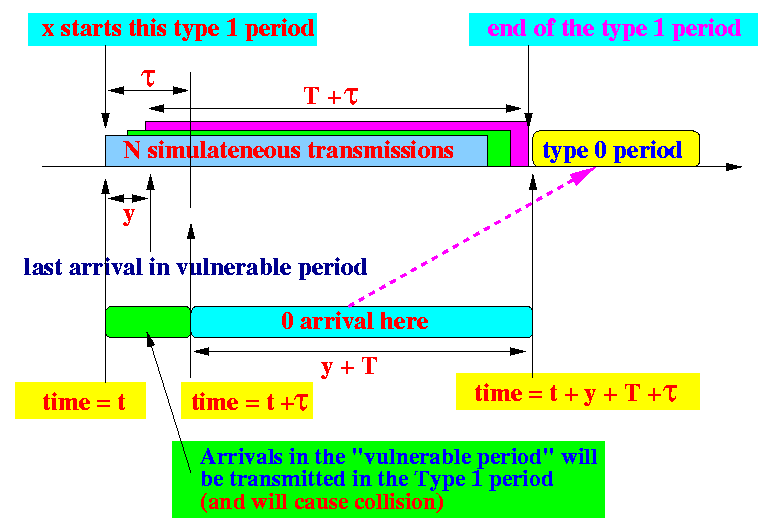
Observation 1:
- Arrivals that arrive
before time t + τ
will not detect
the starting transmission x
Consequently, they will schedule themselves for transmission within the type 1 period (and they will cause a collision)
- Arrivals that arrive
after time t + τ
will detect
the starting transmission x
Consequently, they will schedule themselves for transmission after the type 1 period
Observation 2:
- The total length of the
type 1 period is
T + τ + y
(y is the time of the last arriving packet before deadline τ)
- In order to transit to
a type 0 (idle) period,
there must be
zero (0) arrivals
between:
[t + τ, t + y + T + τ)
I.e., there must be zero (0) arrivals in (T + y) sec
- Arrivals that arrive
before time t + τ
will not detect
the starting transmission x
- Thus:
the probability that a
state 1 period will
transits into a
type 0 period is equal to:
p10 = Ҏ[ 0 arrivals in (T + y) sec ]
If y were a constant, the solution would be simple:
(g(T + y))0 ---------- e-g(T + y) (Poisson arrivals) 0!BUT, y is a random variable
- The technique used to
compute
Ҏ[ 0 arrivals in (T + y) sec ]
is
the Law of Total Probability
(see: click here):
(We divide the range "[0, τ]" into individual time instances u)
p10 = ∑τu=0 Ҏ[ 0 arrivals in T + y | y = u ] × Ҏ[ y = u ] (Law of Tatal Probability) = ∑τu=0 Ҏ[ 0 arrivals in T + u ] × Ҏ[ y = u ]
The sum is in fact an integral because the random variable y is a continuous random variable: p10 = ∫τu=0 Ҏ[ 0 arrivals in T + u ] × fy(u) duThe pdf fy(t) has been discovered before ! From the discussion on the non-persistent CSMA protocol, we got: fy(t) = the probab. density function of y = e-gτ×δ(t) + g×e-g(τ-t) See: click hereThe probability of k arrivals in t sec in a Poisson process is: (gt)k Ҏ[ k arrivals in t sec ] = ---- e-gt k!
So the probability of 0 arrivals in T+u sec in a Poisson process is: (g(T+u))0 Ҏ[ 0 arrivals in T+u sec ] = ----------- e-g(T+u) = e-g(T+u) 0!
Use Maple to compute the integral: > f := g*exp(-g*(tau-u))*exp(-g*(T+u)); f := g exp(-g (tau - u)) exp(-g (T + u)) > integrate(f, u=0..tau); tau g exp(-g tau - g T)
We now only have to compute p11 before we can find the throughput formula for the 1-persistent CSMA protocol....
- Transition from state 1 to state 1:

Note:
- The system moves
from state 1
to state 1
when there is
exactly 1 arrival in the
type 1 period
- Again, the number of arrivals in the type 1 period depends on the duration (length) of the type 1 period
- The system moves
from state 1
to state 1
when there is
exactly 1 arrival in the
type 1 period
- To obtain the duration of the
type 1 period, we must
look at
the anatomy
of a type 1 transmission period:

- Suppose a type 1 period is started at
time t by
the packet transmission x:
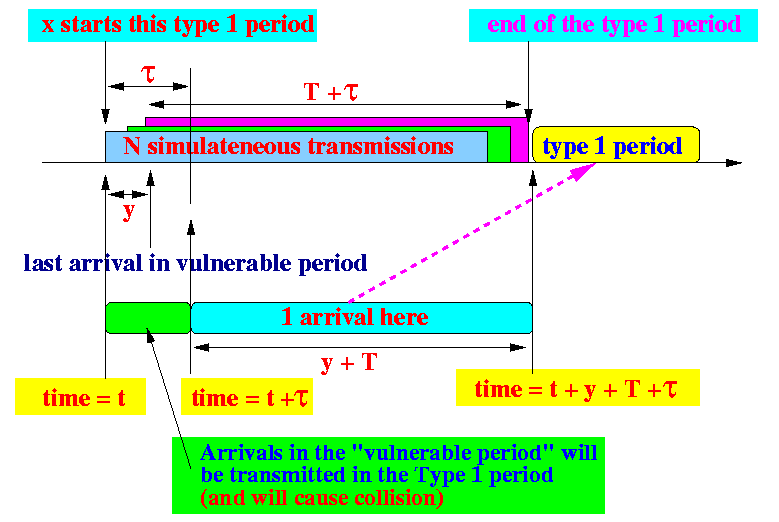
Observation 1:
- Arrivals that arrive
before time t + τ
will not detect
the starting transmission x
Consequently, they will schedule themselves for transmission within the type 1 period (and they will cause a collision)
- Arrivals that arrive
after time t + τ
will detect
the starting transmission x
Consequently, they will schedule themselves for transmission after the type 1 period
Observation 2:
- The total length of the
type 1 period is
T + τ + y
(y is the time of the last arriving packet before deadline τ)
- In order to transit to
a type 1 period,
there must be
one (1) arrival
between:
[t + τ, t + y + T + τ)
I.e., there must be one (1) arrivals in (T + y) sec
- Arrivals that arrive
before time t + τ
will not detect
the starting transmission x
- Thus:
the probability that a
state 1 period will
transits into a
type 0 period is equal to:
p11 = Ҏ[ 1 arrival in (T + y) sec ]
Again, if y were a constant, the solution would be simple:
(g(T + y))1 ---------- e-g(T + y) (Poisson arrivals) 1!BUT, y is a random variable
- We will need use
the Law of Total Probability
to compute
Ҏ[ 0 arrivals in (T + y) sec ]:
(We divide the range "[0, τ]" into individual time instances u)
p11 = ∑τu=0 Ҏ[ 1 arrival in T + y | y = u ] × Ҏ[ y = u ] (Law of Tatal Probability) = ∑τu=0 Ҏ[ 1 arrival in T + u ] × Ҏ[ y = u ]
The sum is in fact an integral because the random variable y is a continuous random variable: p11 = ∫τu=0 Ҏ[ 1 arrival in T + u ] × fy(u) du Again, the difference is the variable u is NOT a random variableFrom the discussion on the non-persistent CSMA protocol, we got: fy(t) = the probab. density function of y = e-gτ×δ(t) + g×e-g(τ-t) See: click hereThe probability of k arrivals in t sec in a Poisson process is: (gt)k Ҏ[ k arrivals in t sec ] = ---- e-gt k!
So the probability of 1 arrival in T+u sec in a Poisson process is: (g(T+u))1 Ҏ[ 1 arrivals in T+u sec ] = ----------- e-g(T+u) = g(T+u)e-g(T+u) 1!
Use Maple to compute the integral: > f := g*(T+u)*g*exp(-g*(tau-u))*exp(-g*(T+u)); 2 f := g (T + u) exp(-g (tau - u)) exp(-g (T + u)) > integrate(f, u=0..tau); 2 1/2 tau (2 T + tau) g exp(-g tau - g T)
- Substitute
the equations
(2),
(4),
(5),
(6),
(7),
(8),
(9),
(10)
in equation
(1) and
after a lot of
Mathematical manipulations,
we will find:
gT e-g(T+2τ) [ 1 + gT + gτ(1 + gT + gτ/2) ] S = -------------------------------------------- ........ (11) g(T + 2τ) - (1 - e-gτ) + (1 + gτ)e-g(T+τ)
- Often, we see the
normalized form
(normalized by packet transmission time
T)
Substitutions used to normalize the throughput expression:
g = offered packet rate per sec G = gT ....... (11) = offered packet rate per packet transmission time T
τ = end to end propagation delay in sec τ a = --- ....... (12) T = end to end propagation delay in packet transmission time T
A useful derived equality: a = τ/T <=> aT = τ <=> agT = gτ <=> aG = gτ
- Normalized throughput expression:
gT e-g(T+2τ) [ 1 + gT + gτ(1 + gT + gτ/2) ] S = -------------------------------------------- ........ (11) g(T + 2τ) - (1 - e-gτ) + (1 + gτ)e-g(T+τ) gT e-(gT+2gτ) [ 1 + gT + gτ(1 + gT + gτ/2) ] = -------------------------------------------- (Subst: G = gT) (gT + 2gτ) - (1 - e-gτ) + (1 + gτ)e-(gT+gτ) G e-(G+2gτ) [ 1 + G + gτ(1 + G + gτ/2) ] = ------------------------------------------ (Subst: aG = gτ) (G + 2gτ) - (1 - e-gτ) + (1 + gτ)e-(G+gτ) G e-(G+2aG) [ 1 + G + aG(1 + G + aG/2) ] = ------------------------------------------ (Rewrite nicer...) (G + 2aG) - (1 - e-aG) + (1 + aG)e-(G+aG) G e-G(1+2a) [ 1 + G + aG(1 + G + aG/2) ] = ------------------------------------------ ......... (12) G(1 + 2a) - (1 - e-aG) + (1 + aG)e-G(1+a)This is the classic form for the throughput of 1-persistent CSMA
- Performance graphs:
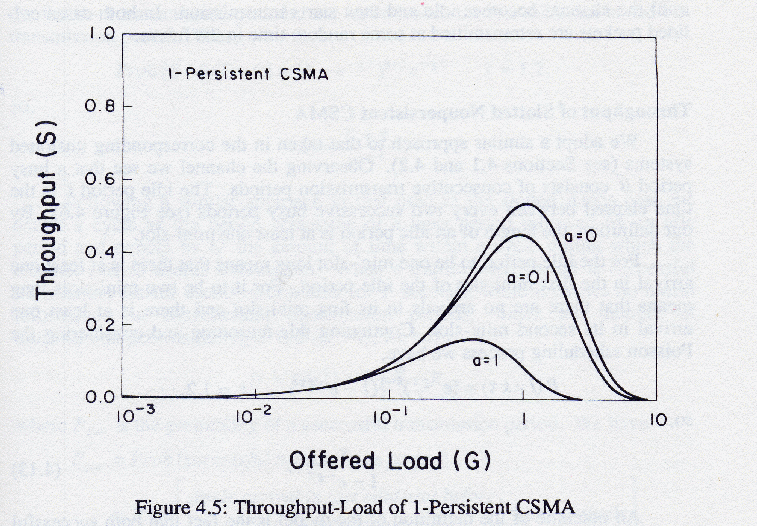
- Comparing Performance:


1-persistent CSMA performs slightly better at lighter loads